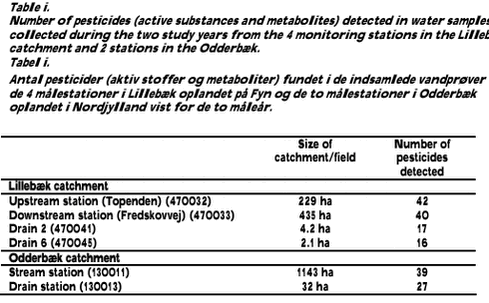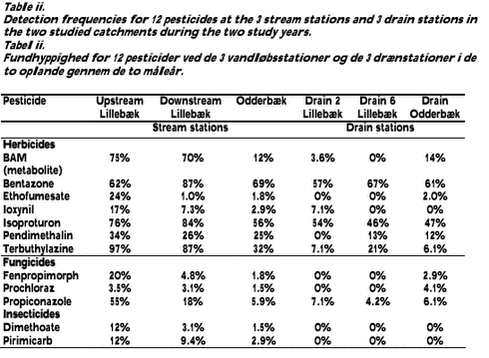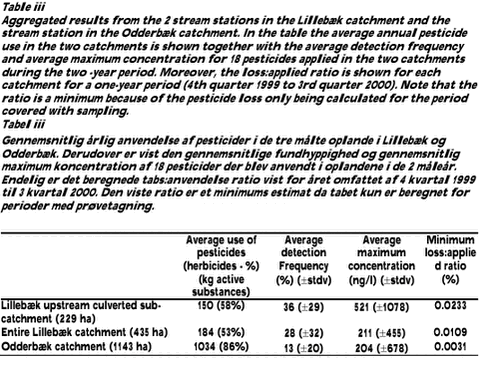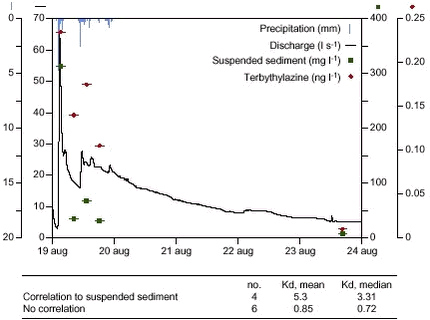Pesticides in streams and subsurface drainage water within two arable catchments in Denmark: Pesticide application, concentration, transport and fateSummary and conclusionsDetection frequency, concentration and loss of 49 pesticides and metabolites were measured during two years (1999 and 2000) in two small Danish arable catchments. The Lillebæk catchment on Funen has an area of 4.35 km2 with 86% agricultural land on loamy soils, and the Odderbæk catchment in Northern Jutland has an area of 11.43 km2 with 83% agricultural land, mainly on sandy soils. Two stream stations were established in the Lillebæk catchment dividing the entire catchment into 2 sub-catchments: an upstream culverted and a downstream sub-catchment with an open stream channel. The fate of pesticides in water, suspended sediment and streambed sediment was measured based on samples/results from 3 stream stations and 3 tile drain stations in the two catchments. The main aggregated results from the two catchments are shown in Tables i-iii. Most of the 49 pesticides and metabolites analysed for in stream water was detected (39-42) (Table i). The number of pesticides detected in tile drainage water was only lesser than in stream water (Table i). This could be explained by the fewer pesticides applied within the smaller subdrained fields especially concerning the two drains in the Lillebæk catchment. Detection frequency and maximum concentration of 18 applied pesticides in the catchments were highest for the upstream culverted sub-catchment in the Lillebæk, followed by the entire Lillebæk catchment and the Odderbæk catchment (Table i). Similarly, the loss:applied ratio was 2 and 8 times, respectively, higher from the upstream culverted sub-catchment than from the entire Lillebæk catchment and the Odderbæk catchment (Table i). Clearly, wind drift and atmospheric deposition of pesticides can be excluded as a pesticide source to the upstream culverted stream. As the culverted stream experienced the highest detection frequency, highest concentrations and highest loss:applied ratio, it indicates that wind drift and atmospheric depostion of pesticides are no major pesticide pathway to any of the streams. Instead, tile drainage water must be a major transport route for at least pesticides as indicated by the results from the upstream culverted catchment which is intensively tile drained. The pesticides measured in the stream can be lost through leaching and macropore flow during rain events following an application (e.g. Laubel et al., 1998; Kronvang et al., 2002). The existence of point sources in the catchment can, however, also play an important role for increased pesticide losses to groundwater and to surface water through tile drains (Bay and Hansen, 2001). Point sources were not investigated in this study as the two tile drains monitored were without contact to farmyards. Pesticides were detected in both tile drains but with a lower detection frequency and concentration than in the stream for most of the pesticides. Moreover, the 2 tile drained fields chosen for this investigation may not be representative for the many tile drains in the entire Lillebæk catchment. Other investigations have shown that high pesticide concentrations can occur in subsurface drainage water without influence from point sources due to translocation of pesticides through macropores (Kronvang, 2002; Holm et al., 2003). An interview with three farmers revealed that pesticide losses from surface runoff could also be a pesticide pathway due to underdimensioned drainage systems in the upstream part of the culverted catchment. A more throrough investigation on the importance of point sources as opposed to field losses of pesticides in catchments will demand a screening for the existence of point sources followed by tracer experiments, together with monitoring of field losses and occurrence of pesticides in streams. Significant relationships were developed between pesticide loss and pesticide application and pesticide physico-chemical properties based on data for 16 pesticides. Such relationships show that small amounts of applied pesticides are quickly transported through the upper soil layer to tile drains and upper groundwater and thereafter carried to surface waters. The steep increases in pesticide concentration and loss during rain and increasing discharge in the streams (storm events) confirm that pesticides are indeed transferred quickly from field to stream in the two studied catchments (Fig. i). The pattern of increase in the pesticide concentration has been documented as depending on pesticide physico-chemical properties, the hydrophobic pesticides peaking early in the storm event together with a peak in suspended sediment concentration (Fig. i).
Many of the hydrophobic pesticides expirienced strong relationships to the concentration of suspended sediment during storm events during all seasons of the year. Moreover, the pesticide content increased in suspended sediment and streambed sediment, especially during the spring spraying season (April-June). Recurrence intervals for pesticide concentrations were calculated for selected pesticides measured in the Lillebæk catchment based on a generalised extreme value distribution. The recurrence intervals for terbuthylazine and diuron at the upstream station in the Lillebæk and isoproturon at the downstream station reveal that high peak concentrations are likely to occur. However, it requires intense sampling programmes in order to detect these peak pesticide concentrations. |



